📞
+91 9266770819 +91 9310161970
📢 Expert Guidance, Comperehensive Resources and Affordable Preparation
📢 Expert Guidance, Comperehensive Resources and Affordable Preparation2
📢 Expert Guidance, Comperehensive Resources and Affordable Preparation3
📢 hello
📢 Expert Guidance, Comperehensive Resources and Affordable Preparation4
📢 Expert Guidance, shdggggggasvgsvfgdvsgfvgdvgfvdgfvgdvfgvdg
Current Affairs Details
Daily Current Affairs
4th INDIA-CENTRAL ASIA DIALOGUE
India–Central Asia Dialogue: 4th Edition – Key Highlights and Analysis

What Is It?
The India–Central Asia Dialogue is a multilateral platform established in 2019 (Samarkand) for structured engagement between India and the five Central Asian Republics:
- Members: India, Kazakhstan, Kyrgyz Republic, Tajikistan, Turkmenistan, Uzbekistan
- Objective: To enhance strategic, political, economic, and cultural cooperation.
Key Objectives of the Dialogue
- Strengthen cooperation in trade, energy, transport, IT, health, and people-to-people contacts.
- Support counter-terrorism, promote regional connectivity, and enable economic integration.
- Act as a platform for India's outreach to Central Asia amid shifting global dynamics.
Major Outcomes of the 4th Dialogue
Counter-Terrorism Cooperation
- Strong condemnation of the Pahalgam terrorist attack.
- Renewed call for the early adoption of the UN Comprehensive Convention on International Terrorism.
- Shared interest in joint exploration and investment in rare earth elements.
- Agreement to convene the Second India–Central Asia Rare Earth Forum soon.
- Emphasis on the optimal use of Chabahar Port and the International North-South Transport Corridor (INSTC).
- Support for Uzbekistan and Turkmenistan’s accession to INSTC to boost overland trade routes.
- Focus on expanding digital payment systems, interbank ties, and trade in national currencies to reduce dependence on third-party systems.
- Discussions on achieving Universal Health Coverage, promoting medical tourism, and integrating traditional medicine systems.
- Support for collaboration on India Stack, biofuels, and solar energy.
- Efforts to build digital public infrastructure and enhance clean energy resilience.
- Central Asian nations reaffirmed support for India’s permanent seat in the UNSC and enhanced participation in platforms like SCO and the UN.
Challenges in India–Central Asia Relations
- Geographical Constraints:
- No direct land borders; Pakistan's denial of transit hampers overland connectivity.
- China’s Dominance:
- The Belt and Road Initiative (BRI) offers massive infrastructure investments, reducing India’s regional influence.
- Afghanistan's Instability:
- Security volatility in Afghanistan disrupts regional cooperation and land-based connectivity.
- Low Bilateral Trade Volume:
- Trade remains under $2 billion (2022–23), far below potential.
- Cultural and Bureaucratic Hurdles:
- Language barriers, red tape, and differing regulations slow down collaboration.
Way Forward
Enhance Multimodal Connectivity
- Scale up Chabahar Port operations and integrate with INSTC more efficiently.
- Use platforms like the TIR Convention to ease transit and customs processes.
- Extend India Stack and Digital Public Infrastructure (DPI) to Central Asia for governance and fintech partnerships.
- Finalize agreements on critical minerals, promote clean energy R&D, and invest in joint green tech ventures.
- Expand ITEC programs, language training, and education scholarships to build people-to-people linkages.
- Establish regular Joint Working Groups in key sectors like health, fintech, climate, and counter-terrorism.
Conclusion
The 4th India–Central Asia Dialogue reflects India’s long-term strategic vision grounded in shared history and regional cooperation. Amid geopolitical challenges—like lack of direct access and China’s expanding influence—India must adopt a resilient, multi-pronged approach. Strengthening connectivity, economic integration, and institutional frameworks will be key to anchoring a robust India–Central Asia partnership for regional peace and prosperity.